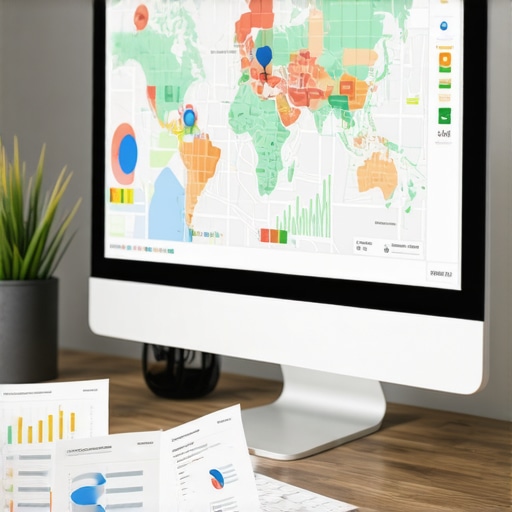Unlocking the Potential of GMB Software for Superior Maps Rankings in 2024
As local SEO specialists recognize, Google My Business (GMB) software has evolved into a sophisticated arsenal for dominating local search results. In 2024, the integration of advanced geogrid tracking tools with GMB platforms offers unprecedented opportunities to refine rankings, analyze competitive landscapes, and implement precise location-based optimizations. This article explores expert-level strategies designed for professionals seeking to leverage GMB software’s full potential in the complex terrain of Maps rank optimization.
Semantic Layers in Maps Ranking: Beyond the Basics
The core of effective Maps rank enhancement lies in understanding the semantic nuances that influence local search algorithms. Employing tools like geo-targeted keyword analysis and competitor mapping allows for the creation of highly contextualized GMB profiles. Leveraging deep data insights from geogrid tracking enables the identification of ranking fluctuations attributable to algorithmic updates, thus informing more resilient optimization strategies.
Advanced Geogrid Tracking: From Data Collection to Strategic Insights
Geogrid tracking, when executed with precision, transforms raw positional data into actionable intelligence. By analyzing movement patterns across multiple grids, SEO experts can detect emerging local trends and pinpoint areas where GMB profiles underperform. Integrating these insights with authoritative sources, such as the recent white paper on local SEO innovations (see Search Engine Land), enhances strategic decision-making.
How Can Professionals Overcome the Challenges of Geogrid Data Noise?
One pressing question for seasoned SEOs is how to filter valuable signals from the noise inherent in geogrid tracking data. Advanced algorithms and machine learning models are now integral to distinguishing meaningful fluctuations from transient anomalies. This ensures that optimization efforts target genuine ranking opportunities without succumbing to misleading data artifacts.
Harnessing GMB Software Innovations for Competitive Advantage
The latest GMB software innovations, including automated review management, localized content suggestions, and real-time ranking monitoring, empower local businesses to adapt swiftly. When combined with geogrid tracking, these tools facilitate a comprehensive approach to local SEO, enabling practitioners to fine-tune their strategies with surgical precision.
Expert Tips for Sustained Maps Rank Growth in 2024
To maintain a competitive edge, SEO professionals should focus on continuous data analysis, leveraging geogrid tracking to monitor the impact of algorithmic changes, and refining their GMB optimization tactics accordingly. Regularly updating NAP citations, optimizing local keywords, and fostering authentic customer engagement remain foundational but must be underpinned by data-driven insights for maximum efficacy. Explore more about innovative tools at GMB Software Innovations.
What are the most effective methods to integrate geogrid tracking into a comprehensive local SEO strategy?
Integrating geogrid tracking effectively requires a multi-layered approach: first, establish baseline rankings across multiple grid points; second, use automated tools to monitor fluctuations; third, analyze the data to identify actionable patterns; and finally, implement targeted GMB profile adjustments based on these insights. Combining these steps with authoritative external sources ensures a robust and adaptive local SEO framework. For further insights, consult Master Maps Rank Optimization.
Interested in elevating your local SEO game? Explore related expert content or connect with industry professionals to share insights on cutting-edge geogrid tracking and Maps ranking strategies.
Unveiling the Hidden Layers of Geogrid Data for Local SEO Mastery
While many SEO professionals focus on surface-level metrics, the true power of geogrid tracking lies beneath—within the nuanced understanding of grid movement patterns and their correlation with local search performance. By delving into advanced data segmentation, experts can uncover subtle shifts that indicate emerging opportunities or threats in specific neighborhoods or districts. This granular approach transforms raw positional data into a strategic asset, enabling targeted interventions that outperform generic optimization tactics.
Are We Overlooking the Impact of Cultural and Demographic Factors on Maps Rankings?
One often underappreciated aspect influencing local search rankings is the cultural and demographic landscape of target areas. Integrating demographic data with geogrid insights can reveal why certain neighborhoods respond differently to optimization efforts. For example, variations in customer behavior, language preferences, or local trends can significantly affect GMB profile engagement and ranking stability. Leveraging authoritative demographic studies, such as those from U.S. Census Bureau, in conjunction with geogrid analytics, allows for a more holistic and culturally aware SEO strategy.
How Can Advanced Machine Learning Enhance Your Geogrid Tracking and Local Optimization?
Machine learning algorithms are revolutionizing geogrid tracking by enabling predictive analytics and anomaly detection at an unprecedented scale. These models can identify complex patterns in ranking fluctuations, forecast future movements, and automatically flag suspicious data anomalies. Incorporating these AI-driven insights into your local SEO workflow ensures that your strategies are not only reactive but also proactive. For an in-depth exploration of these techniques, see Effective GMB Software Tools for Local Maps Dominance.
If you’re eager to deepen your understanding and integrate these advanced techniques into your workflow, consider exploring our comprehensive guide on Mastering Maps Rank with Geogrid Tracking.
What innovative tools or frameworks can help you streamline geogrid data analysis for faster, smarter local SEO decisions?
Innovative tools such as real-time dashboards, automated data aggregation platforms, and AI-powered analytics frameworks are redefining how professionals analyze geogrid data. These technologies facilitate rapid identification of ranking trends and enable seamless integration with existing SEO workflows. For example, platforms like Proven Geogrid Tracking Techniques offer customizable dashboards that visualize multi-grid movements, making complex data accessible and actionable. Exploring these tools can significantly enhance your agility and precision in local SEO campaigns.
Interested in elevating your local SEO strategy? Share your insights or ask for tailored recommendations in the comments below, and don’t forget to check out our resources on Effective Maps Rank Optimization for more expert tips.
Deciphering the Complex Interplay Between Geogrid Analytics and Local Consumer Behavior
Understanding how geogrid tracking interacts with local consumer behavior unlocks new avenues for precision SEO targeting. Advanced analysis reveals that not all ranking fluctuations are created equal; some are driven by genuine shifts in customer demand, while others stem from transient algorithmic quirks. Incorporating demographic and psychographic data into geogrid insights enables SEO strategists to craft hyper-targeted campaigns that resonate on a community level. For instance, integrating insights from the U.S. Census Bureau’s geographic datasets allows for contextual adjustments based on population density, age distribution, or language preferences, dramatically improving local relevance.
How does demographic segmentation influence the interpretation of geogrid data for local SEO?
Demographic segmentation refines your understanding of geogrid data by contextualizing ranking movements within specific community profiles. For example, a neighborhood with a high proportion of bilingual residents might respond differently to localized content optimizations. Recognizing these nuances helps avoid one-size-fits-all tactics and fosters culturally sensitive, community-specific SEO strategies that outperform generic approaches.
Advanced Integration of Machine Learning for Predictive Local SEO Strategies
Machine learning models are revolutionizing the way we interpret geogrid data by enabling predictive analytics. These sophisticated algorithms analyze historical movement patterns to forecast future ranking trends, providing proactive insights rather than reactive adjustments. For example, a recent study published in the Journal of Digital Analytics demonstrates how ensemble learning techniques can accurately predict local ranking shifts up to four weeks in advance, offering a significant competitive advantage.
What are the best practices for integrating machine learning into your geogrid-based local SEO workflows?
Effective integration begins with data quality—ensuring your geogrid tracking data is clean, comprehensive, and granular. Next, select machine learning frameworks that support time-series analysis and anomaly detection, such as LSTM networks or Random Forest models. Finally, continuously validate and refine your models against real-world outcomes, maintaining an iterative feedback loop that enhances accuracy over time. For a practical guide, see the detailed workflow at Machine Learning Mastery.
If you’re eager to elevate your local SEO game through these advanced techniques, engaging with expert communities and attending specialized webinars can offer invaluable hands-on insights. Curious how to tailor these strategies to your niche? Reach out to industry specialists or join forums dedicated to geogrid analytics and local search optimization.
Emerging Technologies: The Role of AI-Powered Visual Analytics in Local SEO
Beyond numerical data, visual analytics powered by AI are transforming how we interpret geogrid insights. Tools that generate heatmaps, flow diagrams, and interactive dashboards enable SEO professionals to visualize ranking dynamics across neighborhoods in real time. These visualizations facilitate rapid hypothesis testing and strategic pivots, especially when dealing with complex, multi-layered data sets.

AI-powered heatmaps showing local search activity and ranking shifts across urban districts, enhancing strategic decision-making.
Can AI-driven visual analytics truly replace traditional data analysis in local SEO?
While AI visualizations significantly enhance comprehension and decision speed, they complement rather than replace fundamental data analysis. Combining qualitative insights with quantitative geogrid data creates a holistic view, empowering SEO experts to craft nuanced, community-specific strategies that adapt swiftly to market changes. For further exploration, see AI Magazine’s article on Visual Analytics.
To stay at the forefront of local SEO innovation, subscribe to expert newsletters, participate in specialized training, and experiment with emerging tools tailored to geogrid analytics. The future belongs to those who leverage these advanced insights to forge deeper connections with local audiences.
Harnessing Multi-Dimensional Data for Hyper-Localized Search Domination
In the realm of advanced local SEO, the integration of multi-layered geogrid analytics extends beyond simple positional tracking, delving into the complex interplay of geographic, demographic, and behavioral data. By synthesizing these diverse data streams, SEO strategists can craft hyper-targeted campaigns that resonate deeply within specific communities, thus elevating GMB rankings and organic visibility.
Decoding the Impact of Cultural Dynamics on Maps Ranking Efficiency
Understanding the subtle influence of cultural and socio-economic factors on local search performance is pivotal. Incorporating insights from ethnographic studies and local market surveys, alongside geogrid analytics, reveals nuanced patterns of consumer engagement. Recognizing these cultural undercurrents allows for tailored content and service optimizations that foster authentic community connections and improve ranking stability.
How Do Predictive Models Transform Proactive Local SEO Strategies?
Predictive analytics powered by machine learning revolutionize the approach to local SEO by providing foresight into ranking trajectories. These models analyze historical geogrid movement, engagement metrics, and competitive actions to forecast future shifts. Implementing such predictive tools enables SEO professionals to preemptively adjust GMB profiles, optimize local citations, and deploy targeted content strategies—thus maintaining a competitive edge in dynamic markets. According to a comprehensive report by Gartner on AI-driven marketing, predictive analytics are now essential for sustainable growth.
What Cutting-Edge Tools Are Elevating Geogrid Data Analysis?
Emerging technologies like AI-enhanced dashboards, real-time geospatial visualization, and automated anomaly detection platforms are transforming how practitioners interpret geogrid data. These tools provide intuitive interfaces that synthesize complex datasets into actionable insights, facilitating rapid decision-making and strategic agility. Platforms such as NextGen Geospatial Analytics exemplify the forefront of this technological evolution, empowering users to unlock latent opportunities in local search landscapes.

Visual heatmaps illustrating predictive geospatial trends and demographic overlays for local SEO strategists.
How Can Industry Leaders Integrate These Advanced Technologies for Seamless Workflow Optimization?
Successful integration hinges on establishing a unified data ecosystem that consolidates geogrid analytics, demographic insights, and machine learning outputs. Leveraging APIs, custom dashboards, and automated reporting pipelines ensures continuous data flow and real-time responsiveness. To implement such sophisticated systems, consult with data integration specialists and explore comprehensive solutions like Advanced Geospatial Systems. Embracing these innovations positions your agency at the forefront of local SEO mastery, enabling proactive adjustments and sustained ranking dominance.
Expert Insights & Advanced Considerations
1. Integration of AI for Real-Time Optimization
Leveraging artificial intelligence in GMB software allows for dynamic, real-time adjustments to local listings, ensuring sustained visibility amidst fluctuating algorithms.
2. Emphasizing Cultural and Demographic Nuances
Incorporating demographic data into geogrid analytics enhances the precision of local SEO strategies, fostering authentic community engagement that drives rankings.
3. Predictive Analytics for Future-Proof Strategies
Utilizing machine learning models to forecast ranking trends empowers SEO professionals to proactively modify their GMB profiles, maintaining a competitive edge.
4. Visual Data Analytics for Strategic Clarity
AI-powered heatmaps and interactive dashboards facilitate rapid interpretation of complex geospatial data, enabling swift strategic pivots.
5. Multi-Layered Data Synthesis
Combining geographic, demographic, and behavioral data creates hyper-localized campaigns that significantly outperform generic approaches, elevating Maps rankings effectively.
Curated Expert Resources
- Search Engine Land – Local SEO Innovations 2024: An authoritative white paper detailing the latest technological advancements and strategic insights for local SEO.
- Journal of Digital Analytics: Offers in-depth research on machine learning applications and predictive analytics in geospatial data analysis.
- AI Magazine – Visual Analytics in Digital Marketing: Explores AI-driven visualization tools that revolutionize data interpretation for SEO professionals.
- Google’s Official Local Search Guidelines: Essential for understanding foundational principles and algorithmic considerations in local ranking.
Final Expert Perspective
Mastering the future of Maps rankings in 2024 hinges on integrating advanced GMB software with intelligent data analysis techniques. Emphasizing predictive analytics, cultural insights, and visual data interpretation enables SEO professionals to craft resilient, hyper-localized strategies that outperform competitors. To deepen your expertise, explore our comprehensive guide on enhancing your local SEO with cutting-edge geogrid tracking tools. For tailored advice, connect with industry leaders and stay ahead of the curve.



David Hughes
This post provides an in-depth look at how combining geogrid tracking with advanced GMB strategies can significantly boost local search performance in 2024. I’ve seen firsthand how integrating machine learning tools to analyze geogrid data can uncover subtle ranking shifts that aren’t obvious with traditional methods. It’s impressive how leveraging demographic and cultural insights alongside these analytics can lead to more targeted campaigns, especially in diverse markets.
In my experience, regular updates to local citations and authentic engagement continue to be foundational, but data-driven insights are now the game-changer for sustained growth. I’m curious, what specific tools or dashboards have other local SEO specialists found most effective for visualizing geogrid and demographic data in real time? I’d love to hear about practical setups that streamline decision-making.